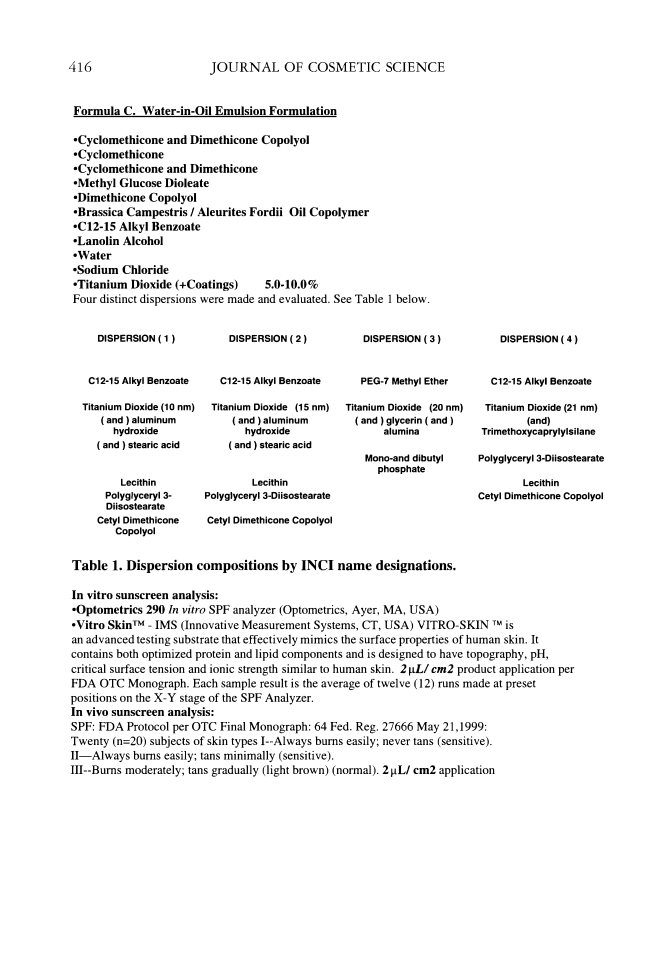2004 ANNUAL SCIENTIFIC SEMINAR 415 tested. To test variability in different types of formulas, both two oil-in-water creams and a water in-oil silicone formulation were evaluated. Tests performed in vitro were via the Optometries 290 SPF Analyzer utilizing IMS Vitro Skin TM as substrate to better mimic skin application. Clinical studies performed at AMA labs used FDA protocol for SPF and JCIA protocol for PPD assessment of UV A protection. Overall the experiments demonstrated that Titanium Dioxide and Zinc Oxide had advantages when preformulated into dispersions depending also on particular varieties and formulations. When the critical wavelength is compared to the ultimate particle size there appears to be a relationship that graphically suggests that critical wavelength will always be above 370 nm. However, some dispersions in which particles are better dispersed and agglomerates are minimal yield critical wavelengths below 370 nm. Materials and Methods: Sunscreen formulations were prepared with the following general compositions that were altered individually to accommodate the different grades of Titanium dioxide used: 10 nm Aluminum Stearate Hydrophobic 15 nm Aluminum Stearate coated Hydrophobic20nm Alumina Glycerin Hydrophilic 21nm Trimethoxycaprylylsilane Hydrophobic 35 nm uncoated Hydrophilic Pigmentary grade 180 nm Rutile Hydrophilic One micron (1,000nm) silicone coated Hydrophobic Formula A. Oil-in-Water Emulsion Formulation nonionic/anionic •Water •Magnesium Aluminum Silicate •Glycerin • Xanthan Gum •Butylene Glycol •Phenoxyethanol/Parabens •Glyceryl Stearate and PEG-100 Stearate •Brassica Campestris / Aleurites Fordii Oil Copolymer •Sorbitan Sesquioleate •DEA-Cetyl Phosphate •C12-15 Alkyl Benzoate •Octyl Palmitate •Cetyl Alcohol •Titanium Dioxide (+Coatings) 5.0-10.0% Formula B. Oil-in-Water Emulsion Formulation liquid crystal gel network •Purified water •Glyceryl stearate, Cetearyl Alcohol, Stearoyl Lactylate •Glycerin •Dimethicone •Caprylyl Methicone •Brassica Campestris / Aleurites Fordi Oil Copolymer •Decyl Shea Butter Esters •Polysorbate 20 •Phenoxyethanol/Parabens • Xanthan Gum •Titanium Dioxide (+Coatings) 5.0-10.0%
416 JOURNAL OF COSMETIC SCIENCE Formula C. Water-in-Oil Emulsion Formulation •Cyclomethicone and Dimethicone Copolyol •Cyclomethicone •Cyclomethicone and Dimethicone •Methyl Glucose Dioleate • Dimethicone Copolyol •Brassica Campestris / Aleurites Fordii Oil Copolymer •C12-15 Alkyl Benzoate • Lanolin Alcohol •Water •Sodium Chloride •Titanium Dioxide (+Coatings) 5.0-10.0% Four distinct dispersions were made and evaluated. See Table 1 below. DISPERSION ( 1 ) C12-15 Alkyl Benzoate Titanium Dioxide (10 nm) ( and ) aluminum hydroxide ( and ) stearic acid Lecithin Polyglyceryl 3- Diisostearate Cetyl Dimethicone Copolyol DISPERSION ( 2 ) C12-15 Alkyl Benzoate Titanium Dioxide (15 nm) ( and ) aluminum hydroxide ( and ) stearic acid Lecithin Polyglyceryl 3-Diisostearate Cetyl Dimethicone Copolyol DISPERSION ( 3 ) PEG-7 Methyl Ether Titanium Dioxide (20 nm) ( and ) glycerin ( and ) alumina Mono-and dibutyl phosphate Table 1. Dispersion compositions by INCi name designations. In vitro sunscreen analysis: •Optometries 290 In vitro SPF analyzer (Optometries, Ayer, MA, USA) DISPERSION ( 4 ) C12-15 Alkyl Benzoate Titanium Dioxide (21 nm) (and) Trimethoxycaprylylsilane Polyglyceryl 3-Diisostearate Lecithin Cetyl Dimethicone Copolyol •Vitro Skin™ - IMS (Innovative Measurement Systems, CT, USA) VITRO-SKIN TM is an advanced testing substrate that effectively mimics the surface properties of human skin. It contains both optimized protein and lipid components and is designed to have topography, pH, critical surface tension and ionic strength similar to human skin. 2 µLI cm2 product application per FDA OTC Monograph. Each sample result is the average of twelve (12) runs made at preset positions on the X-Y stage of the SPF Analyzer. In vivo sunscreen analysis: SPF: FDA Protocol per OTC Final Monograph: 64 Fed. Reg. 27666 May 21,1999: Twenty (n=20) subjects of skin types 1--Always bums easily never tans (sensitive). II-Always bums easily tans minimally (sensitive). 111--Bums moderately tans gradually (light brown) (normal). 2µL/ cm2 application
Purchased for the exclusive use of nofirst nolast (unknown) From: SCC Media Library & Resource Center (library.scconline.org)






































































































